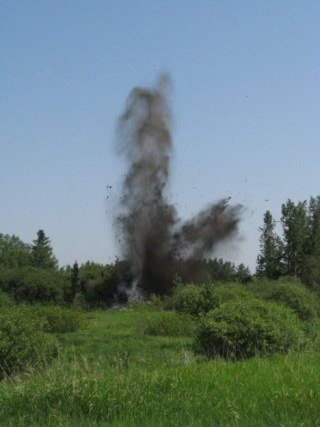By Eraina Hooyer
Staff Reporter
Ponoka County had a blast ridding the waterways of beaver dams on July 3. Explosives Ltd. put on the training and successfully took out four beaver dams that posed a problem to the surrounding area.
“Beaver and beaver dam control in the County can be controversial,” said Shayne Steffen manager of agricultural services. “Beavers can be friend of foe depending on where their dams are located. Many farmers rely on them as a water source for livestock and they provide habitat for waterfowl and other forms of life.”
Every year, depending on the rainfall the County removes approximately 40 dams from the water each year.
The Ponoka County Blasting Program is part of a program that uses machinery and hand removal that allows the County to maintain water flow through their ditches and culverts and helps to keep arable land from flooding. The service is available to ratepayers ‘at cost for product’ for farmers that need dams removed because of flooding.
Ponoka County uses a product called Geogel, which is a stable nitroglycerin based explosive. The sticks themselves are 1 kg sticks that can be cut into smaller pieces. The smaller pieces allows the County to keep the usage to 1 kg or under for each dam while successfully removing them from the water.
A two and a half minute safety fuse is used to ensure safety and enough b-line to get the blasters to safety. After the dams are blasted, trapping is done to keep the dams from being rebuilt in that same location.
With every beaver dam they remove the County is adamant with safety and follows the regulations needed to execute beaver control.
“Prior to blasting, the county has to ensure safety of its employees and utility services, underground and aboveground, and that protocol is followed to minimize environmental impacts,” said Steffen. “Sometimes we refuse or delay a blast because of the regulations or for safety concerns and some ratepayers question ‘why? Because in the good ol’ days we would just buy a case and do it ourselves!’ We respond, ‘the regulations.’”
The County forwards notification before blasting to the Department of Fisheries and Oceans and they can only blast during non-restricted dates to lessen the impacts on fish and aquatic habitat.
The County also does an assessment beforehand to look for overhead dangers, pipeline signs and other utility signage as well as species at risk, endangered or special concern in wetland areas.
An electronic search is also done to show where utility right of ways are located on the land to make sure everything is clear. If there is a nearby line they get First Call out to mark the site and if the dam is within 30m of a utility the County removes the dam without explosives.
Ponoka County works under many regulations and agencies in order to carry out the program including Transportation of Dangerous Goods, Environmental Protection and Enhancement Act, Federal Explosives Act and Regulation, Occupational Health and Safety, Department of Fisheries and Oceans, Alberta Environment, Fish and Wildlife.
